Showing all 25 results
-
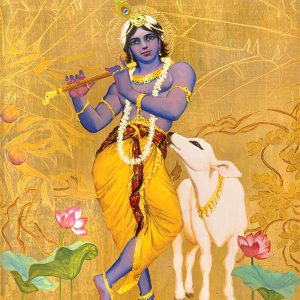
Gopala Krishna
£ 160.00 – £ 850.00 BUYGopala Krishna is the younger form of Lord Krishna who was the protector of the cows and who played his flute, catching the attention of all of the Gopis (maidens) including Radha and making mischief with playful antics.
However you consider Krishna, either as the Supreme God or the 8th avatar of Vishnu, in this beautiful artwork by Giampaolo Tomassetti he is shining the Brahman light from his self-effulgent body. The grace of his form enchants all the living beings around him – notably the calf and the lotus flower. The music of the flute emanates notions of delicate forms of leaves all around and the golden background reminds us of the sheltering Brahmayoti sky (spiritual sky), not dissimilar to the gold background used in medieval gothic art when showing the holy mother and child, reminding once again of the intuition that all world religions had in history.
-
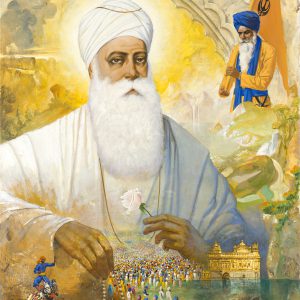
Guru Nanak
£ 135.00 – £ 480.00 BUYGuru Nanak, was the founder of Sikhism and the first of the ten Sikh Gurus. In His eyes, every being is equal. He was an enlightened soul who walked this Earth to spread the message of God.
In this beautiful depiction by Italian artist Giampaolo Tomassetti, the artist uses a vibrant golden hue to depict His aura as being brighter than the sun. His meditative pose and gentle eyes reflect a quiet wisdom. In one hand He holds a white rose in his hand symbolising purity of thought and the transient nature of life, and in the other He hold prayer beads.
On the right a discipline stands head bowed in reverence to the Guru, holding the Nishan Sahib (Sikh flag) with Khanda emblem in the centre. This signifies the power of God, spiritual sovereignty, oneness and the unity of humanity.
On the bottom left of the painting, a Sikh man showcases his skills by riding two horses at the same time. His connection with the horses is strong and symbolises the connection every person must have with God in life “for the body is the horse, upon which one rides to God” says a line in the Guru Granth Sahib, the central religious scripture of Sikhism. We also see a crowd of devotees in front of the Golden Temple, the most important spiritual site in Sikhism.
Tomassetti’s piece brings out the hopeful message of the Sikh culture that we are all God’s creations.
-
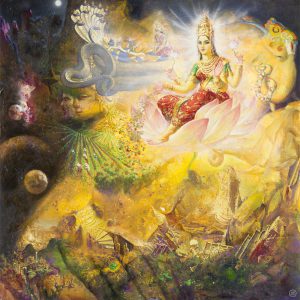
Ma Lakshmi
£ 120.00 – £ 450.00 BUYThe central figure in this piece is Ma Lakshmi, the Hindu Goddess of wealth and prosperity, who is worshipped throughout the year but specifically on Diwali, the festival of lights. Lakshmi, bedecked in the finest jewellery and a magnificent crown, all made of gold, is sitting on a lotus pedestal while also holding the flower in two of her hands. The lotus signifies fortune and prosperity. One of Lakshmi’s hands is seen showering earth with apples that are making the farmers prosperous. The golden backdrop that surrounds Lakshmi symbolises the prosperity that she is bestowing upon earth.
On Lakshmi’s left, the artist of this beautiful artwork, Italian born Giampaolo Tomassetti depicts Lord Vishnu reclining on a serpent, while She sits at His feet. Vishnu is the preserver and protector of the universe, and together with Lakshmi, they represent the growth and prosperity of the universe.
Tomassetti makes a clear distinction between the divine and the real world, which is depicted by way of aerial views of a field, a village and a temple at the bottom of the painting. The painting as a whole is an homage to life in the universe or the cosmos.
-
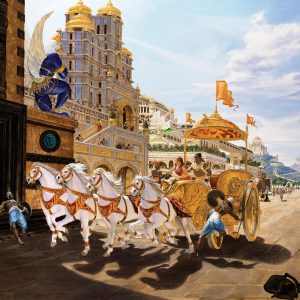
Mahabharata – A Strange Charioteer
£ 180.00 – £ 710.00 BUYThis painting is set within a fabulous landscape, the beautiful town of Dwarka – the kingdom of Lord Krishna. The painting captures the moment lovers flee the town. The excitement of two souls running away in full complicity with one another. But the story is deeper than a runaway chariot driven by a strange charioteer.
A woman named Subhadra, Krishna’s sister, and beside her, Krishna’s best friend Arjuna. Subhadra is promised to another and therefore she planned for Arjuna to kidnap her. They break through the doorway of the city, the guards are pushed aside, as their duty fails short of their destiny.
The artist captured the energy of the moment by depicting the dynamic movement of galloping horses through the city, which is the main focus of this scene.
-
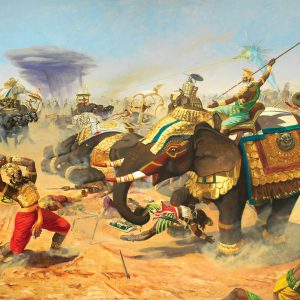
Mahabharata – Bhima and Bhagadatta
£ 145.00 – £ 745.00 BUYBhima is endowed with extraordinary strength and his spectacular feats inspire artistic imagination. He was known for his voracious appetite and in battle he could kill warriors with their elephants only with his mace.
It was possible to trace him on the battlefield simply by following the trail of elephants he had slaughtered. His herculean strength, the fiery character and his total devotion to Lord Krishna and his family led him to perform legendary feats.
The furious and passionate temperament of the great warrior, the bright colours, the red dress, and piercing look of his eyes when fighting – everything speaks about the character of a Kshatriya, always totally committed in defence of society and the moral principles that rule it.
-
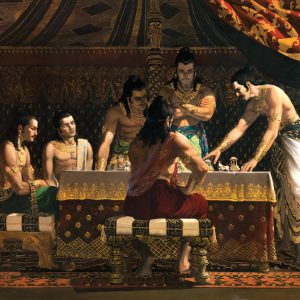
Mahabharata – In the Tent
£ 155.00 – £ 705.00 BUYThe composition and the distribution of the light recall the expressive language of the Italian Baroque period and the atmosphere is inspired by Caravaggio. The dramatic chiaroscuro charges with solemnity the tragic moment that heralds the death of Abhimanyu, the young champion of the Pandava army.
Coloured figurines of soldiers are deployed on the strategic plan, carefully studied by generals. The sharp dark and light enhances the concept that rationality in war has a very relative control over the outcome of the war, other qualities like wrath, courage, strength, resistance and hate contribute strongly to the fulfilment of the destiny. A dramatic sense of the game between karma – destiny – and free will permeate the scene.
-
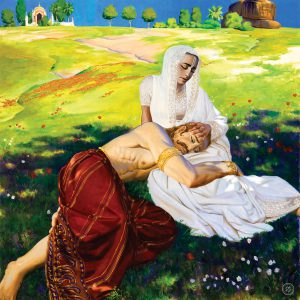
Mahabharata – Karna and Kunti
£ 155.00 – £ 635.00 BUYThis is one of the most moving scenes in the Mahabharata, the moment when Mother Kunti reveals to Karna that he is her first son and therefore the eldest of the Pandava brothers.
Karna is the secret son of Kunti Devi and Surya, the Sun God. On the banks of the Yamuna River, Kunti reveals to Karna the truth about the intimate kinship between them. Their encounter is one of the most poignant moments in the Mahabharata epic, so many sentiments involved in this scene, only piety collecting them all.
-
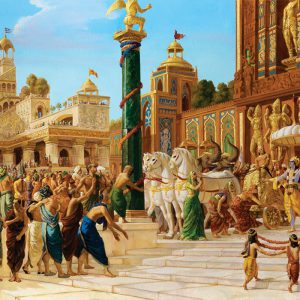
Mahabharata – Krishna entering Dwarka
£ 145.00 – £ 580.00 BUYAfter His travelling around Bharata Varsa Lord Krishna was routinely coming back to his Kingdom of Dwarka. This painting is a tribute of love to Him manifested in the faces and actions of his citizens. Krishna is named also known as Bhagavan, the One that has all transcendental qualities like beauty, power, strength, wealth, fame and compassion.
Here the return of Lord Krishna aroused enthusiasm and joy in the whole city. You can see that all social classes of the Varna-Ashram Dharma are present on the scene, and despite the differences everyone was present. Everyone showing their love and admiration to their Lord. This is to testify the all including society of that time. The three-quarter composition gives the scene a very wide, almost stereoscopic view.
-
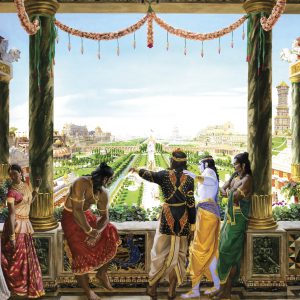
Mahabharata – Krishna in Indraprastha
£ 160.00 – £ 705.00 BUYBefore Indraprastha became the capital of the Pandava’s kingdom, it was the ancient capital of the Kuru clan of which the Pandavas and Kauravas are a part.
At one point in the epic, the Kurus gave the Pandavas a piece of desert land. It had been abandoned for many years and did not look like a place fit to become a capital city. But the Pandavas with the help of Krishna, hard work, determination and skill transformed this wasteland into a beautiful city that would compete with the beauty of Hastinapura, the capital of the empire.
Krishna called upon the heavenly architects Vishvakarma and Mayadhanava, the top designers during that time to transform it into a city fit for the Pandavas. As you can see in the artwork, the architectural accuracy and sophistication made Indraprastha a unique utopia and the perfect example of how cities should be built. Here we can see, in the foreground Maharaj Yudhishthira showing Lord Krishna the great view from the royal palace, as to let us take part in their glance.
-
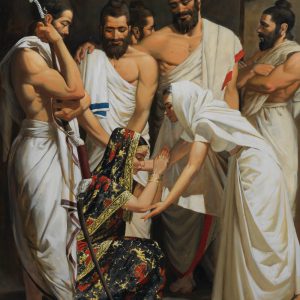
Mahabharata – Kunti and Draupadi
£ 160.00 – £ 795.00 BUYAn intimate simplicity characterises the meeting between Mother Kunti and Draupadi. The painting is devoid of any decorative superfluity. Light is the protagonist of this painting. Taking vantage of the plot in which the Pandavas and their Mother Kunti are in disguise as Brahmanas. They were dressed simply and in white. The white drapery dominates all the lighting, framing the rich black regal sari of Princess Draupadi.
Although Maharaja Draupada’s daughter was elegantly dressed she submits herself to the role of respecting her future mother in law. She was promised to be the wife of the five Pandava brothers, but first she needed to be accepted by their mother!
-
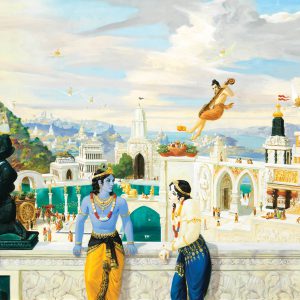
Mahabharata – My Dwarka
£ 155.00 – £ 795.00 BUYCities are a reflection of the ones who built them. The prosperous city of Dwarka, which was capital of Lord Krishna’s kingdom, was a gateway to heaven. Located in modern day Gujarat, the city of Dwarka is often compared to the city of Atlantis, maybe because they both suffered the same fate of being plunged into the depths of the sea.
This painting represents a moment in the daily life of Dwarka. It was described as a vast area in which architecture, palaces and houses are fully merged in the natural landscape of the west coast of India. You can see Krishna and Balarama in a relaxed conversation, framed by marble and bronze. The sky is painted with lightful strokes creating a wide space for legendary figures and flying creatures that break through a banal perception.
-
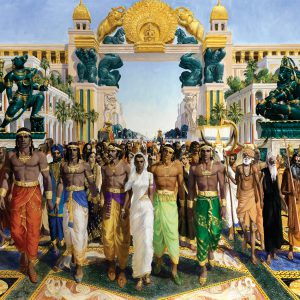
Mahabharata – Pandavas enter Hastinapura
£ 165.00 – £ 660.00 BUYIn this artwork. the Pandava brothers come to Hastinapur after the death of their father, much to the chagrin of Duryodhana. Out of the curiosity and love, all the citizens gather. When the five brothers, enter the city triumphantly with their mother Kunti Devi, accompanied by rishis and great sages.
The composition of this painting shows the frontal view of the crowds that have gathered to greet them and symbolises the entrance of the noble characters into the epic tale, emphasising their presence into the city as well as into the plot of the Mahabharata.
-
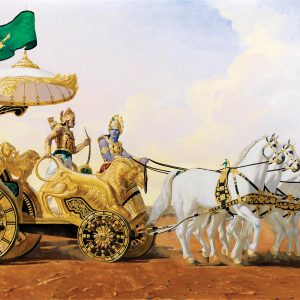
Mahabharata – Parthasarathi
£ 155.00 – £ 755.00 BUYThis is the very heart of Mahabharata, this is the moment that decides how the game will be played. This is the very moment upon which the entire Mahabharata has been written.
The majestic chariot enters the battlefield of Kurukshetra, where the armies are lined up, ready to clash. In these circumstances, Krishna reveals to his friend and devotee Arjuna the secret of Vedic knowledge. The fundamentals of wisdom are conveyed, as he speaks of truth and deception, illusion and reality, virtue, passion and ignorance. The deeper aspects of the psyche, the transcendental nature of the self, the relationship with the Godhead and with other living beings, all come to light very clearly in this dialogue whispered in front of the two armies, and recorded in the Bhagavad Gita (the song of God), one of the primary texts of mankind’s spiritual history.
-
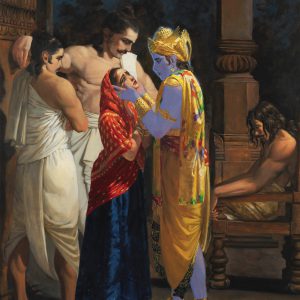
Mahabharata – Save my Honour
£ 160.00 – £ 770.00 BUYOf all the events in the Pandava’s lives, this must be one of the lowest.
Right after having lost the Kingdom and Draupadi’s dignity at the dice contest the Pandavas went into exile in the forest. Krishna saved her honour, by performing a miracle. He provided her unlimited fabric of her sari to prevent her from being disrobed in public.
The nocturnal setting and the light cutting through the darkness, in this moving artwork, contributes to enhance the drama. Krishna consoles Draupadi promising her that everything will be remedied. The desperate face of the woman right in front of the self-effulgent blue God. King Yudhishthira on the right side is the most afflicted, feeling guilty for the big defeat. The painting is in continuity with the “Pandavas were cheated” artwork.
This is the moment when the idea of war mounts seriously although they continued for another 13 year in exile.
-
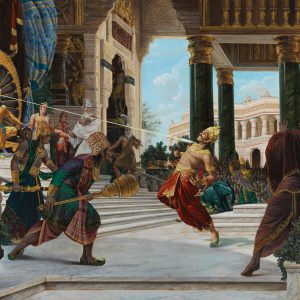
Mahabharata – Shishupala insulting Krishna
£ 160.00 – £ 775.00 BUYThe great proprietary sacrifices were celebrated in rich pavilions specially built by the great architects. The show of opulence was part of the ritual, offered in gratitude to the Lord, to acknowledge His supremacy and invoke protection and prosperity for every citizen. Maharaja Yudhisthira asked Lord Krishna to preside the great Ashwamedha Yajna (the ancient Horse Sacrifice).
The painting depicts the liberation of Shishupala, a powerful and cruel character. You can distinguish the main character of the epic event such as Yudhishthira on Krishna’s left with imperial garments, in the foreground Arjuna with his bow and Bhima with the mace. Right behind them are the two great sages – Bhishmadeva, the great grandfather of the Mahabharata; and the ancient Parashurama, the mystic presence of another Vishnu avatar coming from another era.
-
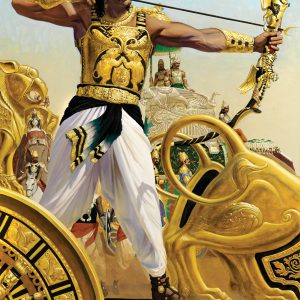
Mahabharata – Shoot him Now – Arjuna
£ 150.00 – £ 695.00 BUYArjuna, son of Indra – the King of the Gods, was the celebrated hero of the Mahabharata. He was a demi-God and possessed admirable virtues such as courage, wisdom, a strong belief in duty and right action.
Here, he is portrayed in the act of shooting a deadly arrow with his divine Gandiva bow, a weapon that terrified the enemy by just looking at. The contrasts between the black and white tones – two extreme points on the light spectrum, enhance the splendour of gold ornaments and emphasise the powerful figure of the great hero.
-
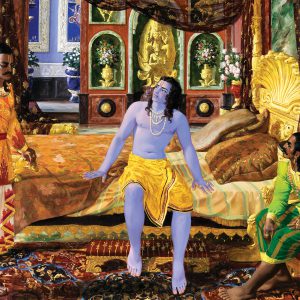
Mahabharata – The Choice
£ 160.00 – £ 790.00 BUYIt is the eve of the great battle of Kurukshetra, when the whole Mahabharata epic is about to be resolved. Sitting on His bed, Krishna announces that He is not going to side with either opponent. He leaves them the choice as to whether to incorporate his powerful personal army into their ranks, or to have Him alone, unarmed and in a secondary role.
Duryodhana, chief of the Kurus, has no hesitation in picking Krishna’s army, where as the Panadavas only desire was to have their dear friend Govinda, Krishna on their side. They are fully convinced that His mere presence on their side will ensure them final victory.
So it is, that Krishna accepts the humble role of driver of Arjuna’s chariot, and thus comes to be known as Parthasarathi.
-
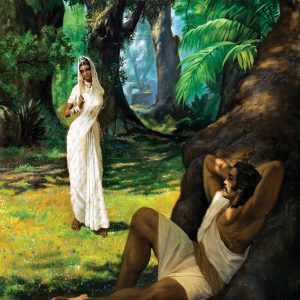
Mahabharata – The Demoness Hidimbi
£ 155.00 – £ 770.00 BUYThis artwork depicts Bhima and Hidimbi’s first meeting. A gorgeous forest becomes the right place for a romantic wild meeting of love, a bucolic scene of seduction with a hint of discreet sensuality.
Hidimbi belonged to the Rakshasa race, giant cannibals with supernatural powers who lived deep in the forests. Despite the major differences between them, their marriage is a short but happy one. Their union generated a much loved son, Ghatotkacha, who was very powerful, humble and loyal.
In the midst of such a dramatic epic, these few tender moments make for a welcome distraction from the pain of troublesome events.
-
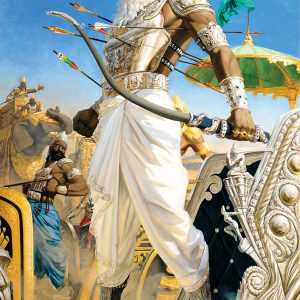
Mahabharata – The Fall of the Hero – Bhishma
£ 220.00 – £ 700.00 BUYThe character of Bhishma in the Mahabharata is the embodiment of the word dharma (duty). His sense of duty and loyalty never wavered.
Bhishma, the great patriarch of the dynasty, was the son to goddess Ganga and always wore silver armour. This artwork depicts the crucial moment on the bloody battlefield, where he is pierced by arrows shot by Arjuna. The painting portrays him moments before his fall, unabashed in his proud and heroic posture. The blue sky serves as a frame to the splendour of the chariot and the armour. This is the prelude to the departure of the noble Bhishmadeva who will be deeply mourned by both sides.
-
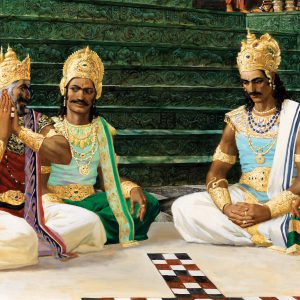
Mahabharata – The Pandavas were cheated
£ 155.00 – £ 770.00 BUYAt the bottom of the steps to the throne, in the middle of the royal room, a tremendous contest happened: it decided the destiny of the Pandava brothers and triggered the tragic event of the Kurukshetra war. The Pandavas are defrauded of royal rights and all belongings by their closest relatives with a rigged game of dice.
Regal dresses hide evil and dishonest personalities. The artist showed mischievous and sinister expressions on the faces of the devious uncle, Shakuni – an expert in the game of dice, and Duryodhana. He wanted to show, expressively, the two very opposing moods of the moment. Arjuna’s resignation, as he knows they are about to lose the contest, and King Yudhishthira’s display of anxiety, for the last throw in the game, where he knows he will lose everything.
-
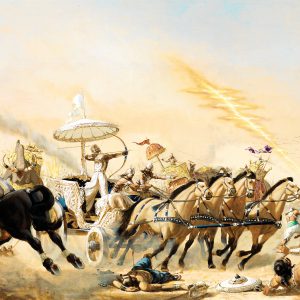
Mahabharata – The Rush of the Hero
£ 165.00 – £ 755.00 BUYBhismadeva, also called Pitamaha – the patriarch, is an oxymoron between old age and his surprising agility and superhuman strength. Fate and code of honour had decided that he was to stand against the Pandavas. Even as he was fighting them in his heart he was on their side.
-
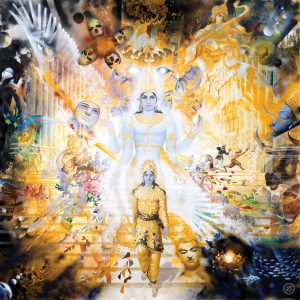
Mahabharata – The Universal Form – Vishva Rupa
£ 165.00 – £ 640.00 BUYIn two moments of the Mahabharata Lord Krishna showed the Vishva Rupa revealing his Divine Nature as Vishnu, the Supreme God. In this painting the artist tries to elaborate His first performance of the so called Universal Form. It is a complex vision explained in an entire chapter of the Bhagavad Gita. The Supreme Being expands in infinite dimensions and entities. The immensity of the universe and the complexity of its constituents are impossible to understand in full. The resulting unusual perception is a network of chaotic and apocalyptic elements, viewed from multiple angels and unusual perspectives as Lord Krishna manifests His Universal Form for the first time.
-
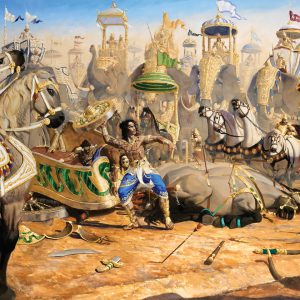
Mahabharata – The Young Hero
£ 150.00 – £ 665.00 BUYThe intense and poignant moment of the death of Abhimanyu. Enemies strongly desired his death and they killed him by deception and betrayal. Surrounded and pierced by innumerable arrows, Abhimanyu stoically fights to his last breath. The young hero’s expected and untimely death enhances his valiant glory.
The artist deliberately seeks to capture the adolescent prowess of the invincible Abhimanyu. Although the body is well shaped and toned, the proportions of the head are slightly larger compared to the body, not unlike the sculpture of David by Michelangelo, thus reflecting the typical physique of a young man not yet in his twenties.
-
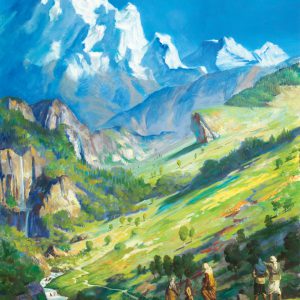
Mahabharata – Towards Badrika Ashram
£ 160.00 – £ 785.00 BUYBrotherhood and love were such that all the brothers and divine Mother Kunti walked a very long trip to the Himalayan mountains to reach a sacred site called Badrika Ashram. Their brother Arjuna was waiting for them there, after so many adventures that lead him even as far as heavenly planets to meet his father Lord Indra – the King of the Gods. He also received boons, such as the legendary bowl that you can see in detail in another painting.
The landscaping, the heavenly and gorgeous view, the small characters, enhance the mystery of the invisible and the spirit of adventurous life.
-
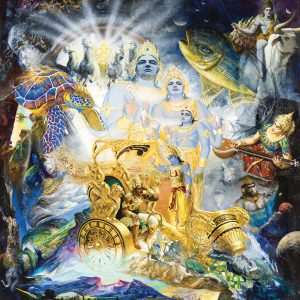
Mahabharata – Virat Roop
£ 1,200.00 BUYThis is the second time Krishna manifests the Virat Roop, but it is at the most important time in the Mahabharata. The Speech of the Bhagavad Gita, is the moment Krishna comes out from the role of Arjuna’s best friend and reveals Himself as the Supreme God Vishnu with all this expansions and that the circumstances of the war was pure illusion, Maya. Arjuna learned that his grief was useless, it was useless to lament. ”Just accept your duty and fight!”.
When Lord Krishna manifests His Universal Form, the world is no longer the same place, the dimensional planes are confused and one becomes lost in amazement. The secure perimeter of the frame contains and holds back the inconceivable universal form, soothing our fears and leaving us in awe.
